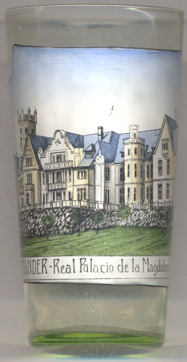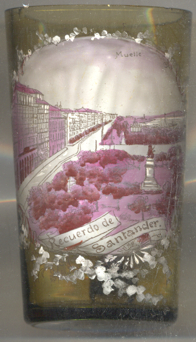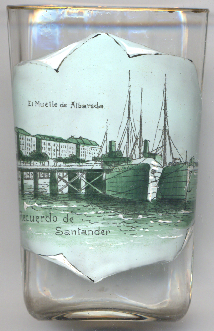

|
| ESPAÑA | Spain |
| Cantabria |
Santander is the capital of the autonomous community and historical region of Cantabria situated on the north coast of Spain. Located east of Gijón and west of Bilbo / Bilbao and Donostia / San Sebastián, the city has a population of about 172,700 (2016).
In Roman times the first written mention appeared, the port being known as Portus Victoriae Iuliobrigensium. Although its name was first mentioned in a document of 1068, the Abbey of the Holy Bodies was already founded in the 9th century. In 1187, King Alfonso VIII of Castile was appointed abbot and master of the town. His jurisdiction facilitatet maritime traffic, fishing and trade. During the 12th and 13th centuries the population was contained within the walls of two different 'pueblas'. La Puebla, the oldest, on the hill overlooking the city facing the bay, included the old castle, the Abbey of the Holy Bodies and the cloister, while Puebla Nueva contained the convent of Santa Clara and San Francisco. Due to its excellent harbour, Santander was an important port for Castile in the later Middle Ages, especially for the trade with the New World. It officially became a city in 1755. In 1941, Santander fell victim to a great fire. The fire led to a major change in the architecture of Santander, away from the older small stone and wood buildings with balconies to the enormous blocks of flats built during the reconstruction. The municipality of Santander has included, since 2009, the city of Santander and the urban areas of Cueto, Monte, Peñacastillo, and San Román, places that were once villages but now are merged with the city.

The  Palacio de la Magdalena [left, no. 3347] was built following an initiative of the
local government of Santander in 1908 for the purpose of providing a seasonal residence for the royal family of Spain.
Funding was provided via popular subscription of the local populace. The design and construction of the palace were overseen
by architects Javier González de Riancho and Gonzalo Bringas Vega, with construction completed in 1912 (another building
designed by these architects and depicted on a glass of this collection is the hydrothermal establishment Las Salinas in
Medina del Campo).
King Alfonso XIII and his family first arrived at the Palacio de la Magdalena in 1913 and returned annually to summer at
the palace through 1930. Following the proclamation of the Second Spanish Republic in 1931 the palace since 1932 was used to
host summer courses of the Menéndez Pelayo International University. In 1977, Don Juan de Borbón sold the
palace and the peninsula back to the city of Santander. The palace, which was declared a historical monument in 1982 and
renovated between 1993 and 1995, continues to be used as a conference and meeting hall. Today, it is the most visited place
in the city of Santander.
Palacio de la Magdalena [left, no. 3347] was built following an initiative of the
local government of Santander in 1908 for the purpose of providing a seasonal residence for the royal family of Spain.
Funding was provided via popular subscription of the local populace. The design and construction of the palace were overseen
by architects Javier González de Riancho and Gonzalo Bringas Vega, with construction completed in 1912 (another building
designed by these architects and depicted on a glass of this collection is the hydrothermal establishment Las Salinas in
Medina del Campo).
King Alfonso XIII and his family first arrived at the Palacio de la Magdalena in 1913 and returned annually to summer at
the palace through 1930. Following the proclamation of the Second Spanish Republic in 1931 the palace since 1932 was used to
host summer courses of the Menéndez Pelayo International University. In 1977, Don Juan de Borbón sold the
palace and the peninsula back to the city of Santander. The palace, which was declared a historical monument in 1982 and
renovated between 1993 and 1995, continues to be used as a conference and meeting hall. Today, it is the most visited place
in the city of Santander.

Glass no. 3655 [near left] shows a view of the
 wharf
wharf
The  monument to Pedro Velarde [foreground right, barely visible] was created in
1880 to commemmorate the hero of the uprising of 2 May 1808. During its history, the monument was relocated several times
and currently is located at the entrance of Plaza Porticada (Plaza Valverde) from Calle Calvo Sotelo.
monument to Pedro Velarde [foreground right, barely visible] was created in
1880 to commemmorate the hero of the uprising of 2 May 1808. During its history, the monument was relocated several times
and currently is located at the entrance of Plaza Porticada (Plaza Valverde) from Calle Calvo Sotelo.

Glass no. 4766 [near left] shows a view of the  Muelle de Albareda
Muelle de Albareda
[https://de.wikipedia.org/wiki/Santander, https://en.wikipedia.org/wiki/Santander;
https://en.wikipedia.org/wiki/Palacio_de_la_Magdalena;
http://loqueseveyoye.blogspot.com/2012/11/monumento-pedro-velarde-en-santander.html]
![[scale]](lineal.jpg)